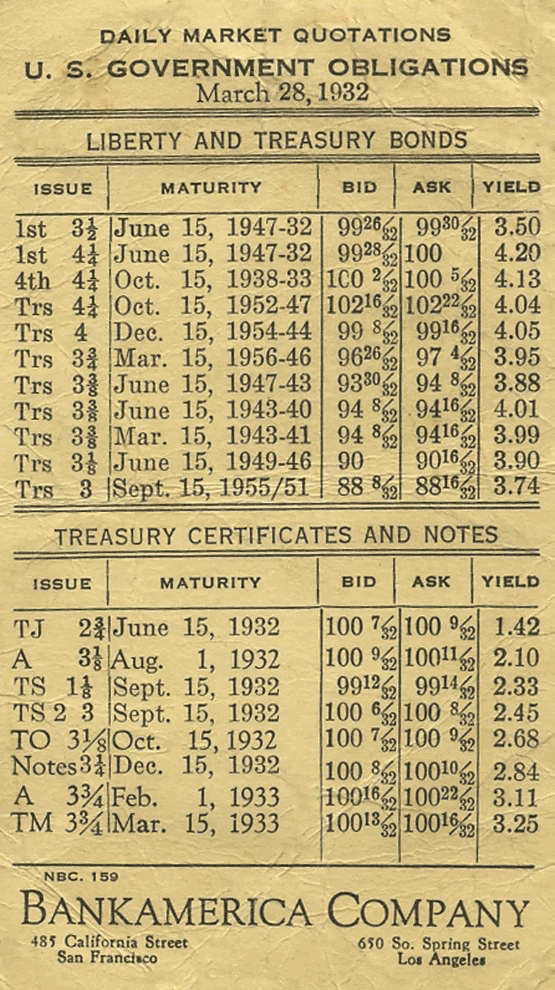Fisk & Hatch Telegraphic Key
This telegraphic key was used by the banking firm of Fisk & Hatch. To send messages by telegraph, codes were used to delineate various financial terms, from the type of securities to the size of a trade. Fisk & Hatch was located on Wall Street, and was instrumental in maintaining the government's credit during the Civil War though its bond business. Fisk & Hatch was a leading trader of Treasury Bonds, and an issued example of a rare Civil War-era coupon bond owned by the firm can be found within The Herbstman Collection.


1865 "Seven-Thirty" Loan Subscription Flyer
for Fisk & Hatch, New York
The Seven-Thirty Loan was a three-year note issued at the end of the Civil War, paying seven and three-tenths percent. This issue was the third in the Seven-Thirty series, had an option to pay interest in gold, and a provision to convert the bonds into 6% Five-Twenty Treasury Bonds.

1865 "Seven-Thirty Loan" Question & Answer Flyer
for Jay Cooke & Co, Philadelphia
Jay Cooke & Company was a banking firm that helped underwrite the sale of government bonds during the Civil War. The firm was instrumental in helping the Union finance the war effort, and by utilizing the telegraph to conduct sales, became the first "wire" bond house in the nation. The firm subsequently went bankrupt during the Panic of 1873.

"Stolen Government Bonds" Flyer
This mid-19th Century flyer advertises various government bonds stolen in New York, offering a reward for their return.
July 11, 1868 Speech of Senator Charles Sumner
Concerning a Bill to Fund The National Debt
This is the full text of speech delivered by Charles Sumner, who served in the Senate from 1851-1874. Sumner was part of a group of politicians known as the "Radical Republicans," a group of Republicans who strongly opposed slavery and the Confederacy, voting for harsh Southern policies during the period of Reconstruction.
Click to view text
Published by F. & G. Rives & George A. Bailey, Washington D.C.

1920 Hillsboro Savings Bank Statement of Condition
This index card-sized statement was printed by the Hillsboro Savings Bank of Hillsboro, Iowa.


Listings of U.S. Government Treasury Securities
Bankers Company of New York June 15, 1930
Printed by the Bankers Company of New York, this pamphlet provided information on the various outstanding Treasury securities. At this point in time, the government still had bonds from First and Fourth Liberty Loan issues outstanding.
.
Daily Government Bond Market Quotation Card
BankAmerica Company March 28, 1932
Issued by the California investment house BankAmerica, (later part of the Bank of America Corporation), this daily bond quotation card provided trading information for various Treasury securities outstanding.
Listed here are the remaining First and Fourth Liberty Loans, issued fifteen years prior, along with other Treasury Bonds, Notes, and Certificates of Indebtedness that were traded daily in the marketplace.
Note: The BID price refers to the price that a buyer or buyers are willing to pay for a security. The ASK price represents the price that a seller or sellers are willing to receive for the security. The YIELD is the rate of return on a particular issue, and is expressed as a percentage based on the interest paid divided by the bond's net purchase price



1936 FDR Presidential Campaign Flyer
This flyer was printed by the Democratic National Campaign Committee for the 1936 Presidential Election. The campaign's message is that under FDR's leadership, America has begun to recover from the Great Depression, along the way reducing government spending.


Union Trust Company of Indianapolis
Bond Coupon Ruler
This ruler was made on behalf of the Union Trust Company, a Indiana-based trust company formed in the late 1800s. Trust Companies engaged in many financial services, including banking, trust management, and asset custodial services. The engraving notes the firm's dealings in both municipal and U.S. Government Treasury Bonds. Rulers such as this were used to separate interest coupons from bonds.

1982 Political Advertisement Postcard
"Presidential Pickats: Hellpers on the Road to Recovery"
This postcard, with its intentional comic misspellings, was meant to criticize government spending during the first Regan Administration. Spendthrift wolves are depicted picketing, each with their own special interest agendas.
Published by Coral-Lee
Drawn by Art Strader

Issued by the Morgan Guaranty Trust Company of New York
Treasury Bond Interest Receipts
These examples, issued by the Morgan Guaranty Trust Company and the State Street Bank and Trust Company, are securities representing interest payments on U.S. Treasury Bonds. Separating a bond's principal from its interest payments was popular in the high interest environment of the 1980's. Different Wall Street firms sold these instruments, with various acronyms such as TIGRS (Treasury Investment Growth Receipts) and CATS (Certificates of Accrual on Treasury Securities). With the end of Treasury-issued bearer securities, physical separation of bond coupons came to end. In 1985, the Treasury Department (using the Federal Reserve as its fiscal agent) began a program known as STRIPS: Separated Trading of Registered Interest and Principal of Securities. These securities met a growing investor demand for zero-coupon Treasury investments.

Issued by the State Street Bank and Trust Company of Boston

Issued by The Bank of New York
Treasury Bond Principal Receipts
Similar to the interest-derived securities shown above, U.S. Treasuries were securitized by their principal payments as well. Sold at a discount to their redemption value, Treasury Bond Principal Receipts were based on the principal due from maturing U.S. Treasury Bonds.
Copyright The Joe I. Herbstman Memorial Collection of American Finance
All Rights Reserved



